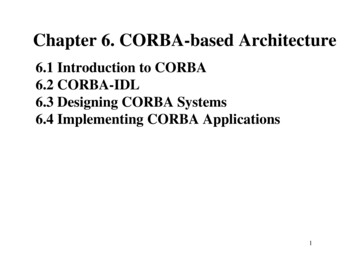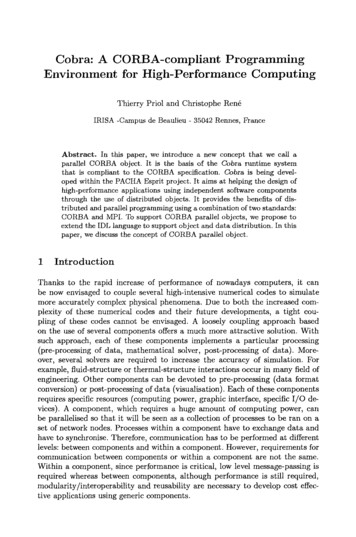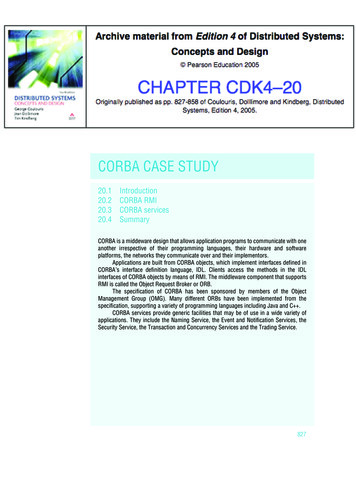
Transcription
1What is CORBA?CORBA (Common Object Request Broker Architecture) is a distributedobject-oriented client/server platform.It includes: an object-oriented Remote Procedure Call (RPC) mechanism object services (such as the Naming or Trading Service) language mappings for different programming languages interoperability protocols programming guidelines and patternsCORBA replaces ad-hoc special-purpose mechanisms (such as socketcommunication) with an open, standardized, scalable, and portableplatform.1IntroductionCopyright 2000–2001 IONA Technologies
The Object Management Group (OMG)2The OMG was formed in 1989 to create specifications for opendistributed computing.Its mission is to" establish industry guidelines and object managementspecifications to provide a common framework for distributedapplication development."The OMG is the world’s largest software consortium with more than800 member organizations.Specifications published by the OMG are free of charge. Vendors ofCORBA technology do not pay a royalty to the OMG.Specifications are developed by consensus of interested submitters.2IntroductionCopyright 2000–2001 IONA Technologies
3What is Client/Server Computing?A client/server computing system has the following characteristics: A number of clients and servers cooperate to carry out acomputational task. Servers are passive entities that offer a service and wait for requestsfrom clients to perform that service. Clients are active entities that obtain service from servers. Clients and servers usually run as processes on different machines(but may run on a single machine or even within a single process). Object-oriented client/server computing adds OO features to thebasic distribution idea: interfaces, messages, inheritance, andpolymorphism.3IntroductionCopyright 2000–2001 IONA Technologies
Advantages and Disadvantages of CORBA4Some advantages: vendor-neutral and open standard, portable, wide variety ofimplementations, hardware platforms, operating systems,languages takes the grunt work out of distributed programmingSome disadvantages: no reference implementation specified by consensus and compromise not perfect can shoot yourself in the foot and blow the whole leg off Still, it’s the best thing going!4IntroductionCopyright 2000–2001 IONA Technologies
Heterogeneity5CORBA can deal with homogeneous and heterogeneousenvironments. The main characteristics to support heterogeneoussystems are: location transparency server transparency language independence implementation independence architecture independence operating system independence protocol independence transport independence5IntroductionCopyright 2000–2001 IONA Technologies
The Object Management Architecture (OMA)6ApplicationInterfacesDomainInterfacesObject Request BrokerObjectServices6IntroductionCopyright 2000–2001 IONA Technologies
Core Components of an ORB7Client ApplicationStaticStubDIIServer ApplicationORBInterfaceORBInterfaceSkeleton DSIClient ORB CoreObjectAdapterServer ORB CoreNetworkIDL-dependentSame for allapplications7IntroductionCopyright 2000–2001 IONA TechnologiesThere may be multipleobject adapters
Request Invocation8Clients invoke requests (send messages) to objects via an objectreference. The object reference (IOR) identifies the target object.When a request is sent by a client, the ORB: locates the target object activates the server if it is not running transmits arguments for the request to the server activates the target object (servant) in the server if it is notinstantiated waits for the request to complete returns the results of the request to the client or returns an exceptionif the request failed8IntroductionCopyright 2000–2001 IONA Technologies
Object Reference Semantics9An object reference is similar to a C class instance pointer, but candenote an object in a remote address space. Every object reference identifies exactly one object instance. Several different references can denote the same object. References can be nil (point nowhere). References can dangle (like C pointers that point at deletedinstances). References are opaque. References are strongly typed. References support late binding. References can be persistent.9IntroductionCopyright 2000–2001 IONA Technologies
Introduction1IDL specifications separate language-independent interfaces fromlanguage-specific implementations.IDL establishes the interface contract between client and server.Language-independent IDL specifications are compiled by an IDLcompiler into APIs for a specific implementation language.IDL is purely declarative. You can neither write executable statements inIDL nor say anything about object state.IDL specifications are analogous to C type and abstract classdefinitions. They define types and interfaces that client and serveragree on for data exchange.You can exchange data between client and server only if the data’stypes are defined in IDL.1The OMG Interface Definition LanguageCopyright 2000–2001 IONA Technologies
IDL Compilation (C loperIDLCompilerx.idlx.cppapp.cppx skel.hx skel.cppClientExecutableRPCC ORBRun-TimeLibrary2The OMG Interface Definition LanguageCopyright 2000–2001 IONA Technologiessrv.cppServerExecutable
IDL Compilation (Mixed JavaCompilerServerDeveloperIDL-to-C Compilerx.javaapp.javaJava .cppx skel.hC ORBRun-Time3The OMG Interface Definition LanguageCopyright 2000–2001 IONA Technologiesx skel.cppsrv.cpp
IDL Source Files4The CORBA specification imposes a number of rules on IDL sourcefiles: IDL source files must end in a .idl extension. IDL is a free-form language. You can use white space freely toformat your specification. Indentation is not lexically significant. IDL source files are preprocessed by the C preprocessor. You canuse #include, macro definitions, etc. Definitions can appear in any order, but you must follow the “definebefore use” rule.4The OMG Interface Definition LanguageCopyright 2000–2001 IONA Technologies
5Comments and Keywords IDL permits both C -style and C-style comments:/** A C-style comment*/// A C -style comment IDL keywords are in lower case (e.g. interface), except for thekeywords TRUE, FALSE, Object, and ValueBase, which must bespelled as shown.5The OMG Interface Definition LanguageCopyright 2000–2001 IONA Technologies
Identifiers6 IDL identifiers can contain letters, digits, and underscores. Forexample:Thermometer, nominal temp IDL identifiers must start with a letter. A leading underscore ispermitted but ignored. The following identifiers are treated asidentical:set temp, set temp Identifiers are case-insensitive, so max and MAX are the sameidentifier, but you must use consistent capitalization. For example,once you have named a construct max, you must continue to refer tothat construct as max (and not as Max or MAX). Try to avoid identifiers that are likely to be keywords in programminglanguages, such as class or package.6The OMG Interface Definition LanguageCopyright 2000–2001 IONA Technologies
Built-In Types7IDL provides a number of integer and floating-point types:TypeSizeRangeshortunsigned shortlongunsigned longlong longunsigned long longfloatdoublelong double 16 bits 16 bits 32 bits 32 bits 64 bits 64 bits 32 bits 64 bits 79 bits 215 to 215 10 to 216 1 231 to 231 10 to 232 1 263 to 263 10 to 264 1IEEE single precisionIEEE double precisionIEEE extended precisionTypes long long, unsigned long long, and long double maynot be supported on all platforms.7The OMG Interface Definition LanguageCopyright 2000–2001 IONA Technologies
Built-In Types (cont.)8CORBA 2.1 added type fixed to IDL:typedef fixed 9,2 AssetValue;typedef fixed 9,4 InterestRate;typedef fixed 31,0 BigInt;//////////up to 9,999,999.99accurate to 0.01up to 99,999.9999,accurate to 0.0001up to 10 31 - 1Fixed-point types have up to 31 decimal digits.Fixed-point types are not subject to the imprecision of floating-pointtypes.Calculations are carried out internally with 62-digit precision.Fixed-point types are useful mainly for monetary calculations.Fixed-point types are not supported by older ORBs.8The OMG Interface Definition LanguageCopyright 2000–2001 IONA Technologies
Built-In Types (cont.)9IDL provides two character types, char and wchar. char is an 8-bit character, wchar is a wide (2- to 6-byte) character. The default codeset for char is ISO Latin-1 (a superset of ASCII),the codeset for wchar is 16-bit Unicode.IDL provides two string types, string and wstring. A string can contain any character except NUL (the character withvalue zero). A wstring can contain any character except acharacter with all bits zero. Strings and wide strings can be unbounded or bounded:typedeftypedeftypedeftypedefstringstring 3 wstringwstring 3 City;Abbreviation;Stadt;Abkuerzung;////////9The OMG Interface Definition LanguageCopyright 2000–2001 IONA TechnologiesUnboundedBoundedUnboundedBounded
10Built-In Types (cont.) IDL type octet provides an 8-bit type that is guaranteed not to betampered with in transit. (All other types are subject to translation,such as codeset translation or byte swapping.)Type octet is useful for transmission of binary data. IDL type boolean provides a type with values TRUE and FALSE. IDL type any provides a universal container type. A value of type any can hold a value of any type, such asboolean, double, or a user-defined type. Values of type any are type safe: you cannot extract a value asthe wrong type. Type any provides introspection: given an any containing avalue of unknown type, you can ask for the type of the containedvalue.10The OMG Interface Definition LanguageCopyright 2000–2001 IONA Technologies
Type Definitions11You can use typedef to create a new name for a type or to rename anexisting type:typedef shorttypedef shorttypedef TempTypeYearType;TempType;TemperatureType;// Bad styleYou should give each application-specific type a name once and thenuse that type name consistently.Judicious use of typedef can make your specification easier tounderstand and more self-documenting.Avoid needless aliasing, such as TempType and TemperatureType.It is confusing and can cause problems in language mappings that usestrict rules about type equivalence.11The OMG Interface Definition LanguageCopyright 2000–2001 IONA Technologies
Enumerations12You can define enumerated types in IDL:enum Color { red, green, blue, black, mauve, orange }; The type Color becomes a named type in its own right. (You do notneed a typedef to name it.) A type name (such as Color) is mandatory. (There are noanonymous enumerated types.) The enumerators enter the enclosing naming scope and must beunique in that scope:enum InteriorColor { white, beige, grey };enum ExteriorColor { yellow, beige, green }; // Error! You cannot control the ordinal values of enumerators:enum Wrong { red 0, blue 8 };// Illegal!12The OMG Interface Definition LanguageCopyright 2000–2001 IONA Technologies
typedef enum Direction { up, down } DirectionType;// Bad style!
Structures13You can define structures containing one or more members of arbitrarytype (including user-defined complex types):struct TimeOfDay {shorthour;// 0 - 23shortminute; // 0 - 59shortsecond; // 0 - 59}; A structure must have at least one member. The structure name is mandatory. (There are no anonymousstructures.) Member names must be unique with the structure. Structures form naming scopes. Avoid use of typedef for structures.13The OMG Interface Definition LanguageCopyright 2000–2001 IONA Technologies
typedef struct TimeOfDayshorthour;// 0shortminute; // 0shortsecond; // 0} DayTime;{- 23- 59- 59// Bad style!
struct Outer {struct FirstNested {longfirst;longsecond;} first;struct SecondNested {longfirst;longsecond;} second;};
struct FirstNested {longfirst;longsecond;};struct SecondNested {longfirst;longsecond;};struct Outer {FirstNestedSecondNested};first;second;
Unions14IDL supports discriminated unions with arbitrary member type:union ColorCount switch (Color) {case red:case green:case blue:unsigned longnum in stock;case black:floatdiscount;default:stringorder details;}; A union must have at least one member. The type name is mandatory. (There are no anonymous unions.) Unions form naming scopes with unique member names.14The OMG Interface Definition LanguageCopyright 2000–2001 IONA Technologies
typedef union DateTime switch (boolean) {case FALSE:Dated;case TRUE:Timet;} DateAndTime;// Bad style!
union BadUnion switch (boolean) {case FALSE:string member 1;case TRUE:floatmember 2;default:octetmember 3;// Error!};
union AgeOpt switch (boolean) {case TRUE:unsigned short age;};
Guidelines for Unions15A few guidelines to make life with unions easier: Do not use char as a discriminator type. Do not use unions to simulate type casting. Avoid using multiple case labels for a single union member. Avoid using the default case. Use unions sparingly. Often, they are abused to create operationsthat are like a Swiss army knife.15The OMG Interface Definition LanguageCopyright 2000–2001 IONA Technologies
union U switch (char) {case ' ':longlong member;//.};
enum InfoKind { text, numeric, none };union Info switch (InfoKind) {case text:string description;case numeric:longindex;};interface Order {void set details(in Info details);};
interface Order {void set text details(in string details);void set details index(in long index);void clear details();};
Arrays16IDL supports single- and multi-dimensional arrays of any element type:typedef Colortypedef stringColorVector[10];IdTable[10][20];You must use a typedef to define array types. The following is illegal:Color ColorVector[10];// Syntax error!You must specify all array dimensions. Open arrays are not supported:typedef string OpenTable[][20]; // Syntax error!Be careful when passing array indexes between address spaces.16The OMG Interface Definition LanguageCopyright 2000–2001 IONA Technologies
typedef stringtypedef IdVectorIdVector[20];IdTable[10];
Sequences17Sequences are variable-length vectors of elements of the same type.Sequences can be unbounded (grow to any length) or bounded (limitedto a maximum number of elements):typedef sequence Color Colors;typedef sequence long, 100 Numbers;The sequence bound must be a non-zero, positive integer constantexpression.You must use a typedef to define sequence types.The element type can be any other type, including a sequence type:typedef sequence Node typedef sequence ListOfNodes ListOfNodes;TreeOfNodes;Sequences can be empty.17The OMG Interface Definition LanguageCopyright 2000–2001 IONA Technologies
typedef sequence sequence Node TreeOfNodes; // Deprecated!
18Sequences or Arrays?Sequences and arrays are similar, so here are a few rules of thumb forwhen to use which: If you have a list of things with fixed number of elements, all of whichexist at all times, use an array. If you require a collection of a varying number of things, use asequence. Use arrays of char to model fixed-length strings. Use sequences to implement sparse arrays. You must use sequences to implement recursive data structures.18The OMG Interface Definition LanguageCopyright 2000–2001 IONA Technologies
typedef char ZIPCode[5];
typedef floatRowType[100];typedef RowType SquareMatrix[100];interface MatrixProcessor {SquareMatrix invert(in SquareMatrix m);// .};
struct CellType {floatvalue;unsigned longcol num;};typedef sequence CellType, 100 RowType;struct RowInfo{RowTyperow vals;unsigned longrow num;};typedef sequence RowInfo, 100 SquareMatrix;
19Recursive TypesIDL does not have pointers, but still supports recursive data types:struct Node {longsequence Node };value;children; Recursion is possible only for structures and unions. Recursion can be achieved only via a sequence member. Theelement type of the sequence must be an enclosing structure orunion. Recursion can span more than one enclosing level. Mutual recursion is not supported by IDL.19The OMG Interface Definition LanguageCopyright 2000–2001 IONA Technologies
enum OpType {OP AND, OP OR, OP NOT,OP BITAND, OP BITOR, OP BITXOR, OP BITNOT};enum NodeKind { LEAF NODE, UNARY NODE, BINARY NODE };union Node switch (NodeKind) {case LEAF NODE:longvalue;case UNARY NODE:struct UnaryOp {OpTypeop;sequence Node, 1 child;} u op;case BINARY NODE:struct BinaryOp {OpTypeop;sequence Node, 2 children;} bin op;};
// .case BINARY NODE:struct BinaryOp {OpType op;Nodechildren[2];} bin op;// .// Illegal!
struct TwoLevelRecursive {string id;struct Nested {longvalue;sequence TwoLevelRecursive children;} data;};// OK
Constants and Literals20You can define a constant of any built-in type (except any) or of anenumerated octetFAMOUS CONST 42;SQRT 2 1.1414213;FIRST 'a';GREETING "Gooday, mate!";LSB MASK 0x01;typedef fixed 6,4 ExchangeRate;const ExchangeRate UNITY 1.0D;enum Color { ultra violent, burned hombre, infra dead };const ColorNICEST COLOR ultra violent;Constants must be initialized by a literal or a constant expression.20The OMG Interface Definition LanguageCopyright 2000–2001 IONA Technologies
const unsigned shortconst longconst long longA 1;B -0234; // Octal 234, decimal 156C 0x234; // Hexadecimal 234, decimal 564
g doubledoubledoubleABCDEF r, fraction, & exponentinteger part and fraction partfraction part onlyinteger part onlyfraction part and exponentinteger part and exponent
constconstconstconstfixedfixedfixedfixedf1f2f3f4 99D;-02.71d; 009270.00D;00.009D;////////fixed 2,0 fixed 3,2 fixed 4,0 fixed 4,3
rcharcharcharcharc1 'c';c2 '\007';c3 '\x41';c4 '\n';c5 '\t';c6 '\v';c7 '\b';c8 '\r';c9 '\f';c10 '\a';c11 '\\';c12 '\?';c13 '\'';//////////////////////////the character cASCII BEL, octal escapeASCII A, hex escapenewlinetabvertical tabbackspacecarriage returnform feedalertbackslashquestion marksingle quote
const wchar X L'X';const wchar OMEGA L'\u03a9';// 'X' as a wide character// Unicode universal character name
S4 "Quote: \"";"hello world";"hello" " world";"\xA" "B";const string 5 BS "Hello";////////string with double quotesimple stringconcatenatetwo characters\('\xA' and 'B'), \not the single\character '\xAB'// Bounded string constant
const wstring LAST WORDS L"My God, it's full of stars!";const wstring 8 O L"Omega: \u3A9";
const boolean CONTRADICTION FALSE;const boolean TAUTOLOGY TRUE;// Bad idea.// Just as bad.
const octet O1 0;const octet O2 0xff;
enum Color { red, green, blue };const FavoriteColor green;const OtherColor ::blue;
Constant Expressions21IDL defines the usual arithmetic and bitwise operators for DLOperators - * / %& The bitwise operators require integral operands. (IDL guarantees two’scomplement representation for integral types.)The operators do not have exactly the same semantics as in C : Arithmetic operators do not support mixed-mode arithmetic. The operator always performs a logical shift.21The OMG Interface Definition LanguageCopyright 2000–2001 IONA Technologies
const short MIN TEMP -10;const short MAX TEMP 35;const short DFLT TEMP (MAX TEMP MIN TEMP) / 2;const float TWO PIES 3.14 * 2.0;// Cannot use 3.14 * 2 here!const fixed YEARLY RATE 0.1875D;const fixed MONTHLY RATE YEARLY RATE / 12D;// Cannot use 12 here!
const long ALL ONES -
language mappings for different programming languages interoperability protocols programming guidelines and patterns CORBA replaces ad-hoc special-purpose mechanisms (such as socket communication) with an open, standardized, scalable, and portable platform.File Size: 1MB











